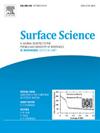金属表面上高偶极merocyanine分子的化学相互作用和分子生长:光电子能谱研究
IF 2.1
4区 化学
Q3 CHEMISTRY, PHYSICAL
引用次数: 0
摘要
分子在表面上的生长和排列是一个有趣的研究课题,因为在这里获得的见解可能与有机电子器件具有重要的相关性。虽然通常采用简单的刚性分子作为模型系统,但我们展示了在Au(100), Ag(100)和Cu(100)金属单晶上研究的高度偶极merocyanine的结果。利用紫外(UPS)和x射线光电子能谱(XPS)分析了从亚单层到多层的薄膜厚度。对于单层结构,有很强的正面取向的迹象,两个分子的硫原子都与金属表面结合。在Ag和Au(100)上,由于与底物之间的电荷转移,硫原子失去了部分或全部的固有电荷,而在Cu(100)上,形成了一个强的金属-硫键。底物与分子之间的相互作用也可以从UPS中最高占据分子轨道特征的强度和宽度中看出。在多层沉积中,观察到电离能逐渐降低,这可能是由于反平行二聚体的形成,随后由于在较厚的层中形成了扩展的分子聚集体而增加了电荷载流子的离域。有趣的是,在Cu(100)上,已经观察到聚集相的沉积要低得多,这表明了底物-分子相互作用对随后的薄膜生长的重要性。因此,本研究对不同金属表面上merocyanine薄膜的界面形成和电子结构演变提供了详细的了解。本文章由计算机程序翻译,如有差异,请以英文原文为准。

Chemical interaction and molecular growth of a highly dipolar merocyanine molecule on metal surfaces: A photoelectron spectroscopy study
The growth and ordering of molecules on surfaces is an intriguing research topic as insights gained here can be of significant relevance for organic electronic devices. While often simple, rigid molecules are employed as model systems, we show results for a highly dipolar merocyanine which is studied on top of Au(100), Ag(100) and Cu(100) metal single crystals. Film thicknesses ranging from sub-monolayer to multilayer regimes are analyzed using UV (UPS) and X-ray photoelectron spectroscopy (XPS). For the monolayer regime, there is strong indication of face-on orientation, with both of the molecules’ sulfur atoms bonding to the metal surfaces. Here, on Ag and Au(100) the sulfur atoms lose some or all of their intrinsic charges due to a charge transfer with the substrate, while on Cu(100) a strong metal-sulfur bond forms. The interaction between the substrate and the molecules can also be seen in the intensity and width of the highest occupied molecular orbital features in UPS. Upon multilayer deposition, a gradual lowering in ionization energy is observed, likely due to the formation of antiparallel dimers followed by an increased charge carrier delocalization due to the formation of an extended molecular aggregate for thicker layers. Interestingly, on Cu(100) the aggregated phase is already observed for much lower deposition, showing the importance of substrate-molecule interaction on the subsequent film growth. Therefore, this study offers a detailed understanding of the interface formation and electronic structure evolution for merocyanine films on different metal surfaces.
求助全文
通过发布文献求助,成功后即可免费获取论文全文。
去求助
来源期刊

Surface Science
化学-物理:凝聚态物理
CiteScore
3.30
自引率
5.30%
发文量
137
审稿时长
25 days
期刊介绍:
Surface Science is devoted to elucidating the fundamental aspects of chemistry and physics occurring at a wide range of surfaces and interfaces and to disseminating this knowledge fast. The journal welcomes a broad spectrum of topics, including but not limited to:
• model systems (e.g. in Ultra High Vacuum) under well-controlled reactive conditions
• nanoscale science and engineering, including manipulation of matter at the atomic/molecular scale and assembly phenomena
• reactivity of surfaces as related to various applied areas including heterogeneous catalysis, chemistry at electrified interfaces, and semiconductors functionalization
• phenomena at interfaces relevant to energy storage and conversion, and fuels production and utilization
• surface reactivity for environmental protection and pollution remediation
• interactions at surfaces of soft matter, including polymers and biomaterials.
Both experimental and theoretical work, including modeling, is within the scope of the journal. Work published in Surface Science reaches a wide readership, from chemistry and physics to biology and materials science and engineering, providing an excellent forum for cross-fertilization of ideas and broad dissemination of scientific discoveries.
 求助内容:
求助内容: 应助结果提醒方式:
应助结果提醒方式:


